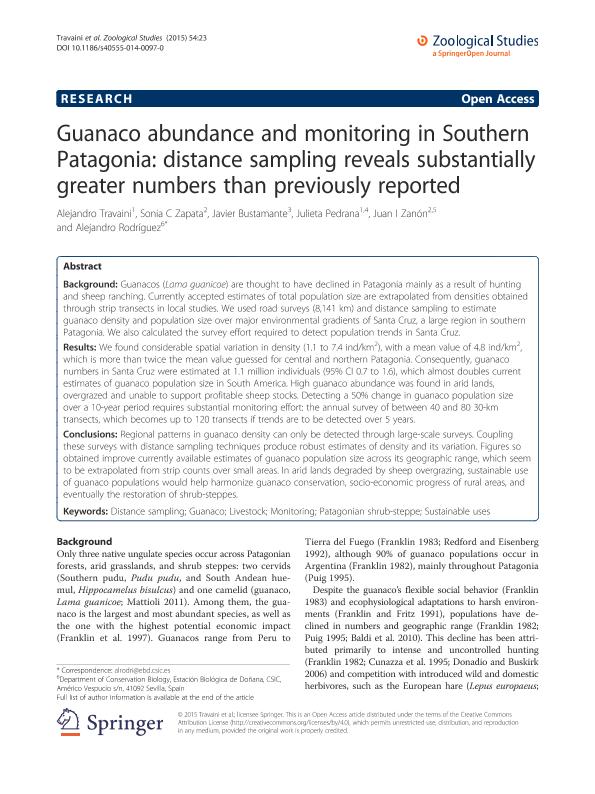Artículo
Guanaco abundance and monitoring in Southern Patagonia: distance sampling reveals substantially greater numbers than previously reported
Travaini, Alejandro ; Zapata, Sonia Cristina; Bustamante, Javier; Pedrana, Julieta
; Zapata, Sonia Cristina; Bustamante, Javier; Pedrana, Julieta ; Zanón Martínez, Juan Ignacio
; Zanón Martínez, Juan Ignacio ; Rodriguez, Alejandro
; Rodriguez, Alejandro
 ; Zapata, Sonia Cristina; Bustamante, Javier; Pedrana, Julieta
; Zapata, Sonia Cristina; Bustamante, Javier; Pedrana, Julieta ; Zanón Martínez, Juan Ignacio
; Zanón Martínez, Juan Ignacio ; Rodriguez, Alejandro
; Rodriguez, Alejandro
Fecha de publicación:
01/2015
Editorial:
Springer
Revista:
Zoological Studies
ISSN:
1810-522X
Idioma:
Inglés
Tipo de recurso:
Artículo publicado
Clasificación temática:
Resumen
Background: Guanacos (Lama guanicoe) are thought to have declined in Patagonia mainly as a result of hunting and sheep ranching. Currently accepted estimates of total population size are extrapolated from densities obtained through strip transects in local studies. We used road surveys (8,141 km) and distance sampling to estimate guanaco density and population size over major environmental gradients of Santa Cruz, a large region in southern Patagonia. We also calculated the survey effort required to detect population trends in Santa Cruz. Results: We found considerable spatial variation in density (1.1 to 7.4 ind/km2), with a mean value of 4.8 ind/km2, which is more than twice the mean value guessed for central and northern Patagonia. Consequently, guanaco numbers in Santa Cruz were estimated at 1.1 million individuals (95% CI 0.7 to 1.6), which almost doubles current estimates of guanaco population size in South America. High guanaco abundance was found in arid lands, overgrazed and unable to support profitable sheep stocks. Detecting a 50% change in guanaco population size over a 10-year period requires substantial monitoring effort: the annual survey of between 40 and 80 30-km transects, which becomes up to 120 transects if trends are to be detected over 5 years. Conclusions: Regional patterns in guanaco density can only be detected through large-scale surveys. Coupling these surveys with distance sampling techniques produce robust estimates of density and its variation. Figures so obtained improve currently available estimates of guanaco population size across its geographic range, which seem to be extrapolated from strip counts over small areas. In arid lands degraded by sheep overgrazing, sustainable use of guanaco populations would help harmonize guanaco conservation, socio-economic progress of rural areas, and eventually the restoration of shrub-steppes.
Archivos asociados
Licencia
Identificadores
Colecciones
Articulos(CCT - MAR DEL PLATA)
Articulos de CTRO.CIENTIFICO TECNOL.CONICET - MAR DEL PLATA
Articulos de CTRO.CIENTIFICO TECNOL.CONICET - MAR DEL PLATA
Articulos(INCITAP)
Articulos de INST.D/CS D/L/TIERRA Y AMBIENTALES D/L/PAMPA
Articulos de INST.D/CS D/L/TIERRA Y AMBIENTALES D/L/PAMPA
Citación
Travaini, Alejandro; Zapata, Sonia Cristina; Bustamante, Javier; Pedrana, Julieta; Zanón Martínez, Juan Ignacio; et al.; Guanaco abundance and monitoring in Southern Patagonia: distance sampling reveals substantially greater numbers than previously reported; Springer; Zoological Studies; 54; 23; 1-2015; 1-12
Compartir
Altmétricas



